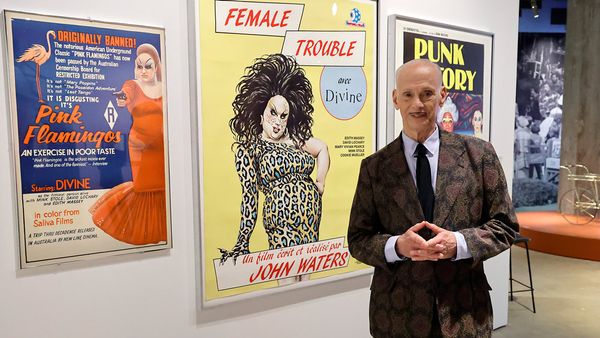
May 13, 2017
Out There :: Lighting Up the Legion of Honor
Roberto Friedman READ TIME: 3 MIN.
Out There trucked out to the Palace of the Legion of Honor in Lincoln Park last week to catch up with two exhibits there. The crowd-pleaser is "Monet - The Early Years," now in its final weeks (through May 29). But the more unusual exhibition is "Urs Fischer: The Public & the Private," marking the first time that contemporary art has been installed among the traditional masterpieces at the Legion (through July 2).
Fine Arts Museums of San Francisco director Max Hollein said, "Fischer's site-specific installation at the Legion of Honor is a unique manifestation of artistic imagination, expanded context and institutional challenge." The Swiss artist presents more than 30 works installed throughout the Court of Honor, the rotunda and the upper-level galleries at the Legion of Honor.
The juxtaposition of Fischer's bronze sculptures with Auguste Rodin's "The Thinker" in the usually spare Court of Honor serves notice that something new is going on inside the galleries. Perhaps the show's most immediately striking installation is "Dazzled" (2016), a sculpture placed in the gallery devoted to English paintings. The two oversized, disembodied eyes of "Dazzled" make the museumgoer conscious of the act of looking, and isn't intent observation what art appreciation is all about?
"Drained" is one of two wall art-pieces that share space with the Legion's permanent collection in other galleries. The sculpture "Invisible Mother" is a striking use of a human skeleton in the Legion's central atrium. The attention-grabbing "Mr. E & Spotzy" consists of stainless steel boxes polished to a mirror-like sheen, the better to reflect the Rodin sculptures in the space around it.
In "Fiction" (2012), a hidden motor makes a wooden table shiver and shake so much you can't focus on the print in an open book, the table's sole, trembling object. "Snail Crossing Helmet" (2016) is a visual poem on the idea of slow vs. fast, as a snail makes its way across a shining silver motorcycle helmet. Both are, in effect, shells protecting organic matter.
But the exhibit's crowning glory is "Adam" (2014-17), Fischer's sculpture of a standing man originally eight-feet-tall. We say "originally" because his wick is burning and he's in the process of melting, leaving the wax that once was his body coiled and pooled on the gallery floor. Adam is doomed, like the figures of Rodin's "Gates of Hell." He's looking mortality in the face, just like the rest of us.
Composing Critics
The American Composers Forum Board of Directors will present its 2017 Champion of New Music award to percussionist, radio producer and Other Minds artistic and executive director Charles Amirkhanian. Amirkhanian will receive the award on Sat., May 20, during an Other Minds concert featuring the Gamelan masterpieces of Lou Harrison at Mission Dolores in San Francisco.
Just a day before this honor, Other Minds Records will release "Composer-Critics of The New York Herald Tribune," a CD featuring works by music critics for that newspaper who were also composers. The department was headed by the great gay composer Virgil Thomson, and between the years 1940 and 1954 included such seminal figures in 20th-century music as Paul Bowles, Lou Harrison, Peggy Glanville-Hicks and John Cage. All of these men were gay, and we're not sure about Peggy. Bowles is represented on the disc by his "Music for a Farce" (1938), Glanville-Hicks by her "Sonata for Piano and Percussion" (1951-52). Thomson's "Capital Capitals" (1927) sets a 1917 text written by lesbian genius Gertrude Stein in a way that clearly presages his opera "Four Saints in Three Acts," which also sets texts by Stein.
Cage's "String Quartet in Four Parts" (1949-50) proves that the avant-garde master was equally adept at traditional music structures. But the disc's most beautiful piece of music is (no surprise) Harrison's "Suite for Cello and Harp" (1949), from a score written for, but ultimately not used in, a film about the prehistoric paintings in the Lascaux Caves of France. Maybe call it early rock music?







